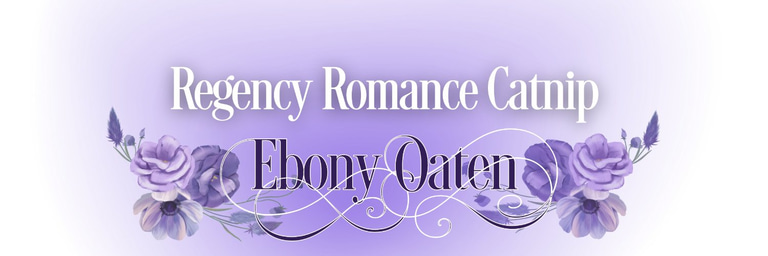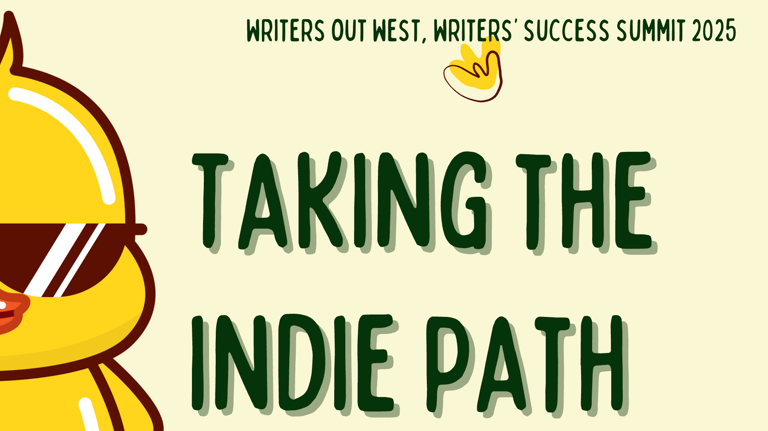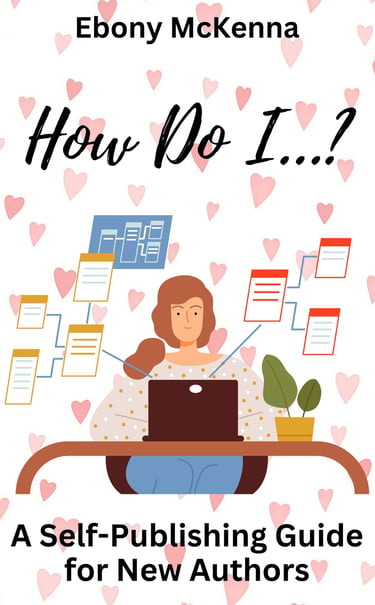Self-Publishing 101
Step-by-step instructions that I can update as systems and retailers change - and they're constantly changing!
Minimum requirements:
Edited manuscript formatted as doc or docx, or into an 'epub' file for ebooks and pdf for print
Cover .jpg file for ebooks and .pdf for print
Draft2Digital account - to load 'wide'
Amazon KDP account - to load to Amazon and enrol in KU if you choose to.
ISBNs: From myidentifiers at Thorpe Bowker in Australia, so that you, the author, are the publisher. You will need your own Australian ISBNs in order to claim publishing and author lending rights.
WISE/Airwallex account linked to your Australian Bank account for receiving monthly royalties. Amazon will not pay in $US unless you reach a set amount, and even then they might send a paper cheque. A WHAAAAAT? Yes. Use Wise or Airwallex to create an account that can accept $US and you'll get paid every month.
Website. I use Hostinger as it's easy to purchase a domain name and host server, then I can update and create new pages for my latest releases. (Bonus, authors can create an online store page with very low fees, to directly sell books to readers.)
Formatting 101:
While you can load up a doc or docx file to KDP to make an ebook, it's best to format the file first, so that readers get the best experience possible. Go here for KDP specific information.
Draft 2 Digital offers free formatting and shows you what the reader will see when they get your ebook. They have a few different styles to choose from. Start here.
Covers:
A quick Google search will reveal many 'ready made' book covers of all genres that are low cost. Quality varies. Canva subscriptions offer many pre-made book cover templates that can be adjusted and re-purposed.
Browse bookstores and bestseller lists in your genre to make sure your book fits in with books that are already doing well. Don't slavishly copy them, but examine the elements that resonate with the reading audience.
TIP: Create a cover that 'blends' over the spine and to the back cover, so there are no set lines. That way, if the printing is mildly off-plumb, it won't be noticeable.
The Reader Always Comes First:
Yes, this book is your baby, but as the book changes from manuscript to retail product, it transitions from being all about the author to becoming all about the reader. Make it as easy as possible for the reader to see your book - from the first impression of the cover, to the enticing blurb, to the opening paragraphs - as something that will delight and entertain them.
Blurbs:
You've written a 90k word novel, but those 250 word blurbs are killing you!
Blurbs call for intense focus. Think of the emotions you want to elicit from your reader. Each genre has specific requirements - a mystery needs an undercurrent of discovery to solve it, Romance needs emotion and yearning, Thrillers need a sense of fear/dread etc etc.
Who is the protagonist and what do they want?
What is stopping them/ who is in their way?
Who is the next protagonist or the antagonist, and what do they want?
Who or what is thwarting their plans?
When you focus on these main elements, pretend someone else wrote the book and you're helping another author out.
Or, swap books with an author friend and write blurbs for each other.
Google 'how to write blurbs' to look at examples and get ideas. Read blurbs to get a feel for the rhythm and pacing.
Pricing:
This is always a tricky thing to get right. If you have a series of books, it's often a good idea to create a shorter book / novella that is related to the series, and give that away everywhere for free.
To do this, load the book in D2D and select everyone except Amazon. Price it as free.
Then load the same title to Amazon, price it at 99c. Once it's live, contact Amazon through the help section and ask them to price match it to $0 and provide links where that same title is free on other platforms.
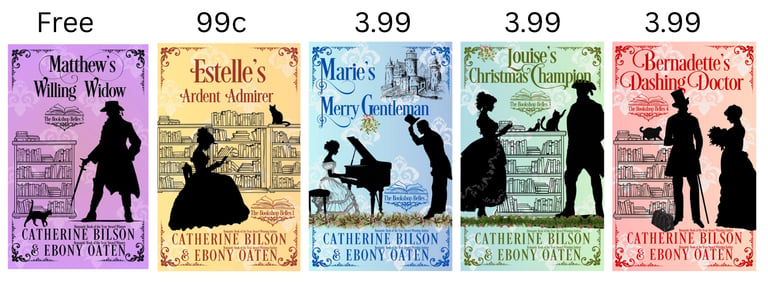

Pricing Example:
I co-wrote books 1 -4 of The Bookshop Belles (above) with Catherine Bilson over a period of 6 months . It was the fastest I've ever written anything, and I loved it.
They were released one week apart, from the end of March into April, 2025.
We later released Matthew's Willing Widow (July 1, 2025) as a bonus novella. Initially the novels were more expensive. $3.99 for book 1, $ 5.99 for the next 3. As the books have been out for 3 months, we then set up a price discount. They are in KU will probably stay there for the first year before we send them all 'wide'.
Editing:
Structural edit: A 'whole picture' edit where the entire structure is examined for coherence, plot holes, overall character inconsistencies etc. May include instructions to re-order sections to make the story stronger and more satisfying for readers. Does each scene drive the story forward? (ie, if you take it out, does it affect the plot at all?) Does every character belong in the story? Is backstory used to enhance the plot or does it slow things down? Has the author delivered on the promise of the premise?
Structural edit is NOT the time to send ARCs (Advance Review Copies) out to readers for feedback. There is still far too much work to do. You may have some 'Beta readers' who might offer constructive opinions at this stage though.
Line Edit: Does each line of text work hard enough to entertain the reader and encourage them to keep turning the pages? Are words or descriptions being overused? Is the author falling into poor habits?
Copy edit: Spelling, punctuation and grammar get a consistency check in this round. At this point, you can send an ARC out for feedback and early reviews.
Proof reading: This is your last chance to spot any remaining typos. Good luck catching them!
Newsletter Magnets?
Do you have a newsletter? I do for English readers, but not for readers of other languages. That is on my to-do list!
The easiest way to get started is to head over to Substack (or platforms like that) Substack is free to use. Share links to those posts across social media platforms to bring people over.
Send subscribers welcome emails.
Consider offering a newsletter magnet - a free shorter read, something that's not available anywhere else. Giving readers something 'exclusive' is a great way to get people reading your titles. (And always make sure you put plenty of links to your other books in the back of that free read, to encourage readers to find more of your books.
Kindle Unlimited or Wide?
Some genres do better in Kindle Unlimited, where authors are paid on the number of page reads, rather than direct sales of each book, others do very well 'wide' on all platforms.
Going wide means you can get your titles into Australian public libraries, and you can make some titles available for free, permanently. There are a great many advantages and it often comes down to personal preference.
KU terms last three months and the title must be exclusive to the Amazon platform and nowhere else. It's often a good idea to release to KU for two terms and promote as a 'limited release', then move to wide. The only thing I do not recommend is switching back and forth. Leave a title in KU for two or three terms before moving it, then leave it wide. Or go wide from the beginning (and enrol in Kobo Plus, which does not demand exclusivity.)
Growing newsletters
Bookfunnel is the world leader in helping authors grow their newsletters. https://dashboard.bookfunnel.com/ has many subscription levels.
Membership allows authors to join promotions and give aways, but the really great feature is it collects email addresses to help authors grow their newsletters. At the moment, there's no automatic integration from Bookfunnel to Substack, but I'm sure this will change in the future.
Other services include MailerLite.com, which can be integrated with Bookfunnel. They have different pricing plans depending on how many subscribers you have. It's important to have regular culls so that you don't end up paying for inactive subscribers who don't open your emails!
What cracks me up is that since I've started publishing in multiple languages, I have not set up any extra newsletters or social media in other languages ... yet they're selling very well because I'm placing ads on Facebook. In fact, I'm scratching my head wondering why I even bother with newsletters at all when it's advertising that's doing all the work!
NOTE: The aim is to write multiple books over many years. I highly recommend writing at least three - either as standalone novels all in the same genre or as a 'series' of connected books.
I do not recommend authors writing three completely different books, ie, one mystery thriller, one YA sci-fi and one literary comedy of one man's struggle to buy a house. While this might delight the author and add variety and novelty to their life, it will not grow your audience. Readers don't want to see your range - if they like your first book, they will want 'the same but different' for the next. Give the readers what they want.
DO NOT READ REVIEWS!
No matter what.
Do not read reviews that complete strangers post on Goodreads, Amazon, Barnes and Noble, blogs, anything. That way lies madness. The author's job is done once the book is released. Once it's released, it's not your book any more. Just look at the following example:

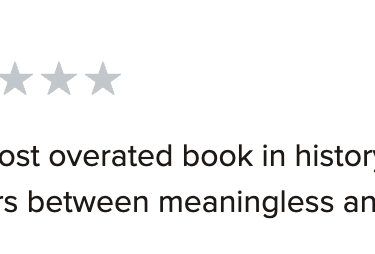

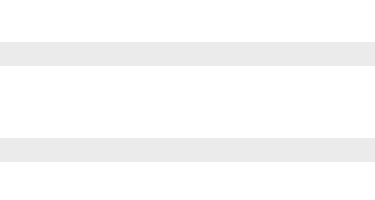
This book in Goodreads has received 107,040 One-star ratings and reviews, and 161,381 two-star ratings and reviews. But look at the percentages - it's only a combined 5% of all reviews. It's for Jane Austen's Pride and Prejudice, one of the most beloved novels of all times. To the author, the reviews will be 'wrong'. To the reader, it's their opinion and that's what a review is; one person's opinion. Ignore them.
NOW WHAT?
Keep writing. Write multiple books and plan their release. Treat self-publishing as a business, because it is.
Self-publishing can mean the author has to do everything themselves, BUT what it really means is authors need to organise everything themselves.
GET ORGANISED!
Use planners or spreadsheets to keep track of your forward releases. Write your series (or pair) of novels first, then load them up onto platforms and set a release date a month or two ahead.
Delegate some jobs. The ones you hate, not the writing. The writing is what you love, right? Or at least, you love having written.
Increase your daily writing goals
I adore Word Keeper Alpha. It's a free service that encourages authors to keep track of their word counts. I started off June with a bang, then completed the 'Matthew novella' and then got stuck into a project called Troubled Waters... and then dropped that as Catherine and I pivoted to a different projects and I spent a good deal of time doing accounts and removing old titles from KU so that I can release them wide by September, 2025.
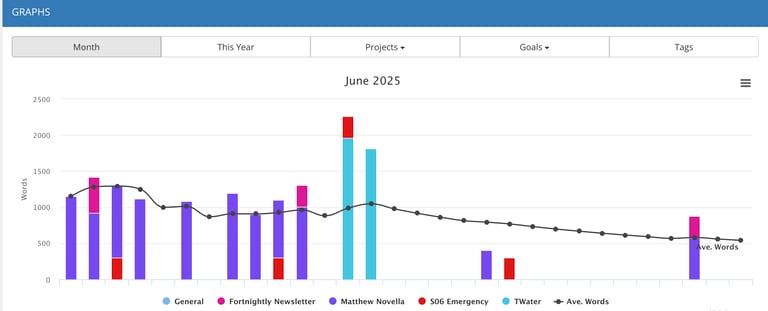

Can AI help?
Yes and no. If you want to be a better writer (or painter, or cook, or gardener) the only way to get better is to write/paint/cook/garden as much as you can and to get better at it.
There are huge ethical issues with using AI. For a start, much of the writing AI is based on is wholesale theft of copyrighted materials, (my books are there in the soup) with no compensation to the authors for the use of their works, their labour, their skills. Yeah, I'm shitty about that. Congrats on reading down this far for my first swear.
AI for writing is based on theft. It uses VAST amounts of electricity (and because it's proprietary, they won't tell us how much juice it squeezes) and it uses massive amounts of water to cool the processing towers. Again, they don't tell us how much.
Using AI to come up with ideas? Jesus wept. Ideas are nothing! Do you hear me? Ideas are the very basic start of the process. I am going to get on my high horse here and say if you struggle to come up with ideas, then maybe writing isn't really for you. Writers have so many ideas they don't know where to start. Writers are having ideas all the time. Some make us smile, others make us break out in a cold sweat. But the ideas on their own are NOTHING. Everyone has them; it's what you do with them that makes you a writer. It's the way you tell the story that makes it "yours".
No idea in and of itself is all that original. It's the style, voice and passion behind the writing that makes it uniquely yours.
Any prompt you feed into an AI generator will forever go into the soup. This will get slopped out to any user further down the track. Your combination of ideas will get served up to them.
Don't add to the soup voluntarily! They're already stealing our work without our permission as it is.
Talk to your author friends. Join a writers' group in your area/state. Brainstorm with real people and throw ideas around. This is how you do it.
Say, "Yes, and," when people suggest things. It's an improv session. "Yes, and" spurs more ideas and you'll find something that resonates.
(Saying, "No, that's not what I'm after" shuts people down and you won't get what you need.)
So, when can I use AI?
I use AI for translating. Does this make me a hypocrite? Quite possibly. My translation journey came about because I'd paid a human translator $400 US for two novellas . . . and the result was sub-optimal. I told them up front I'd put their name on the cover as the translator, hoping that would assist them to do a good job. I suspect, but will never know, if he fed the novellas through a translation app anyway. I later asked Spanish readers if it made sense. Their report - it was a hot mess. (Esto es un desastre tremendo.)
I now use two services: ScribeShadowAI for translating fiction and DeepL for translating blurbs and newsletters.
The words, phrasing and style in English are all mine to begin with, and I purchase a service to translate my words into another language. (If you're interested in translating, wait until you have a few novels and release them all in one language at a time. If you sign up to ScribeShadow, Use EBONYSCODE for a discount.)
Also, translations don't feed my words into another vat of AI soup. These services translate, but they don't ingest and take those words to later spit out to other users. At least, they don't at the moment.
ISBN 101: (International Serialised Book Number)
Thorpe Bowker is the registered provider of ISBNs in Australia. It costs $55 to register with them, then $88 for a pack of 10 ISBNs. You will need one ISBN per title per format.
ie, Book 1 - paperback, ebook and audio book = 3 ISBNs. Don't bother with buying QR codes or barcodes, that's just an upsell.
PRINT formatting and publishing
You will need an interior PDF file to do print, and book cover pdf file for the cover 'wrap' which includes front, spine and back cover.
Use Ingram Spark (they print in Australia and will distribute worldwide) to load your files. You will need your ISBN, which you've bought from Thorpe Bowker. You don't have to distribute right away - save that for when you are happy with the book. Order yourself some author copies. If they look great, click that 'distribute' button.
Once you approve the distribution option, Ingram Spark will charge fees to add revisions to the cover and interior, so make sure it's right before you press 'go'. Distribute means your print title will show up in 'online' stores such as Barnes and Noble, Apple, etc. When setting the price on Ingram, set the books to non-returnable. (This is an excellent way to lose money)
Offer at least a 40% discount. Yes, this is what retailers and library distributors expect when ordering books. Make sure you price your books so that even with the discount you make some profit - and keep an eye on printing costs.
If you want to make your print and ebooks available on Amazon, it's best to load them directly to KDP. You title will show up in a few days and be available to purchase all over the world.
Tutorials: People all over the world make 'walk through' tutorials for every part of self-publishing, from formatting a word file to loading up to retailers. Retailers have recently added 'cover description' sections that we now need to fill out. It does feel like every few months there is something new to learn!
Draft 2 Digital has free formatting if you have no experience at all in creating an interior PDF file.
Vellum is the BEST for formatting and generating interior PDF files and ebook files, but it's Macintosh only and is expensive.
Atticus is an excellent formatting app for all systems and is far cheaper. Both are one-off purchases.
Affinity Publisher is also very good for formatting books and can be used on any computer, not just Mac. It's excellent for creating non-fiction with lots of photographs and text that flows. It's a one-off purchase.
Adobe In-Design is the original, but it's a monthly subscription and is the most expensive. However, you can do EVERYTHING and it's amazing. I don't have it, as I have Affinity, Atticus, Vellum and D2D. One more will break my brain!
I will keep learning as much as I can, and I will keep sharing what I learn with others. This is how my brain works. Self-publishing is never static. The only constant thing about self-publishing is that it's constantly changing.
Above all, keep writing.
Free Self-Publishing Self-Help
Click this link here to go to a Google Drive and download either a kindle.mobi or generic.epub of
How Do I ...? A Self-Publishing
Guide For New Authors.
It covers more things
an author will need
to self-publish their books.
* * * *
AUDIO BOOKS
Audio books are huge.
You can record them yourself and load them onto multiple platforms including Youtube.
Yes, just the audio, with a rolling video clip running on the screen. It doesn't need to be you in the camera.
Even if you load the audio and people can listen for free, when you reach a certain number of subscribers you can earn money with ad placements
Here's a tutorial from my writing collaborator Catherine Bilson.
I know very little about audio, so I'm grateful Catherine has done the work here!
Self-Publishing Guides
These are fantastic resources for editing your own fiction, and then getting your books into public libraries across Australia
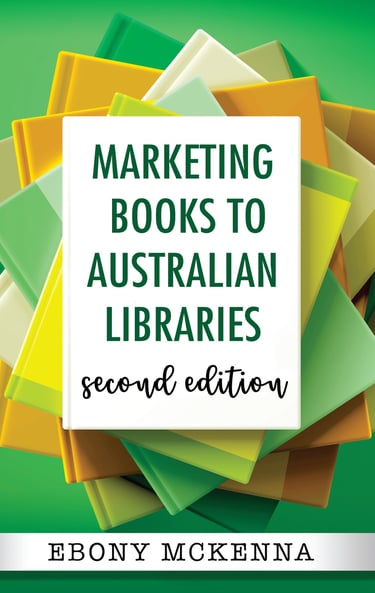

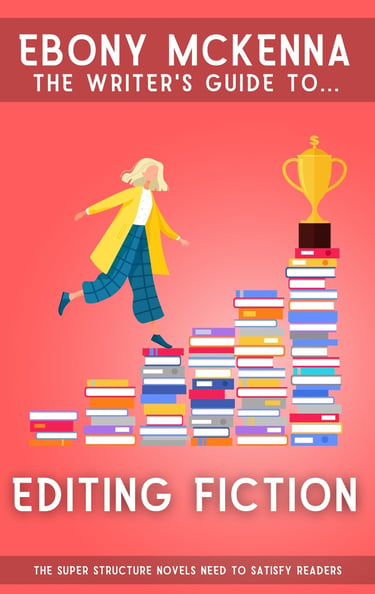

Publishing Resources
Earn extra royalties through Public Lending Rights and Digital Lending Rights by getting your book into Australian libraries - the right way.
Expert Editing
Socialising...
Come and chat with me on socials, here's where I hang out far too much when I should be writing!
Contact me here:
Join my reader newsletter
© 2025. All rights reserved.
